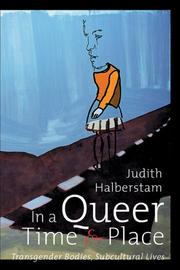| Listing 1 - 3 of 3 |
Sort by
|
Book
ISBN: 2913167640 9782913167643 Year: 2008 Publisher: Nantes: Odin,
Abstract | Keywords | Export | Availability | Bookmark
 Loading...
Loading...Choose an application
- Reference Manager
- EndNote
- RefWorks (Direct export to RefWorks)
Book
ISBN: 1619254247 9781619254244 9781619254237 1619254239 Year: 2015 Publisher: Ipswich, Massachusetts Amenia, NY
Abstract | Keywords | Export | Availability | Bookmark
 Loading...
Loading...Choose an application
- Reference Manager
- EndNote
- RefWorks (Direct export to RefWorks)
So much of great literature centres on explorations of gender, sex, and sexuality. What does it mean to be a proper man or woman; what if one cannot be properly called either? Should one wield one's sexual power politically? What is the relation between law, divine or secular, and sexuality? These are just some of the questions that this volume examines through an analysis of a wide range of texts. Each essay is 2,500 to 5,000 words in length, and all essays conclude with a list of "Works Cited," along with endnotes. Finally, the volume's appendixes offer a section of useful reference resources.
Sexual minorities in literature. --- Gender identity in literature. --- Homosexuality in literature. --- Bisexuality in literature. --- Transsexuals in literature. --- Sexual minorities in literature --- Gender identity in literature --- Homosexuality in literature --- Bisexuality in literature --- Transsexuals in literature

ISBN: 0814735843 0814735851 0814737498 0814790895 Year: 2005 Publisher: New York ; London : New York University Press,
Abstract | Keywords | Export | Availability | Bookmark
 Loading...
Loading...Choose an application
- Reference Manager
- EndNote
- RefWorks (Direct export to RefWorks)
Examines the significance of the transgender body in a provocative collection of essays on queer time and space. She presents a series of case studies focused on the meanings of masculinity in its dominant and alternative forms, especially female and trans-masculinities as they exist within subcultures, and are appropriated within mainstream culture. In a Queer Time and Place opens with a probing analysis of the life and death of Brandon Teena, a young transgender man who was brutally murdered in small-town Nebraska. After looking at mainstream representations of the transgender body as exhibited in the media frenzy surrounding this highly visible case and the Oscar-winning film based on Brandon's story, Boys Don’t Cry, Halberstam turns her attention to the cultural and artistic production of queers themselves. She examines the “transgender gaze,” as rendered in small art-house films like By Hook or By Crook, as well as figurations of ambiguous embodiment in the art of Del LaGrace Volcano, Jenny Saville, Eva Hesse, Shirin Neshat, and others. She then exposes the influence of lesbian drag king cultures upon hetero-male comic films, such as Austin Powers and The Full Monty, and, finally, points to dyke subcultures as one site for the development of queer counterpublics and queer temporalities.
Sociology of the family. Sociology of sexuality --- Theatrical science --- Gender identity. --- Marginality, Social. --- Sex role. --- Transgender people in literature. --- Transgender people in motion pictures. --- Transgenderism. --- Teena, Brandon, --- Gender nonconformity. --- Gender variance (Gender nonconformity) --- Genderqueer --- Non-binary gender --- TGNC (Transgender and gender nonconformity) --- Transgenderism --- Gender expression --- Gender identity --- Sex identity (Gender identity) --- Sexual identity (Gender identity) --- Identity (Psychology) --- Sex (Psychology) --- Queer theory --- Gender role --- Gender roles --- Gendered role --- Gendered roles --- Role, Gender --- Role, Gendered --- Role, Sex --- Roles, Gender --- Roles, Gendered --- Roles, Sex --- Sex roles --- Sex differences (Psychology) --- Social role --- Sexism --- Motion pictures --- Exclusion, Social --- Marginal peoples --- Social exclusion --- Social marginality --- Assimilation (Sociology) --- Culture conflict --- Social isolation --- Sociology --- People with social disabilities --- Brandon, Teena, --- Gender dysphoria --- POLITICAL SCIENCE --- SOCIAL SCIENCE --- Transsexuals in motion pictures --- Transsexuals in literature --- Transsexualism --- Marginality, Social --- Sex role --- Transgender people in literature --- Transgender people in motion pictures --- Gender nonconformity --- Transsexualilsm. --- Transsexuals in motion pictures. --- Transsexuals in literature. --- Public Policy --- Cultural Policy. --- Anthropology --- Cultural. --- Popular Culture. --- Transexualism --- Transexuality --- Transsexuality --- Psychological aspects --- Transsexual people --- LGBTQ+ films --- Queer studies
| Listing 1 - 3 of 3 |
Sort by
|

 Search
Search Feedback
Feedback About UniCat
About UniCat  Help
Help News
News